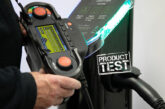
Pete (Monty) Monfort, Director of Arena Training Centre and Monty Electrics, tests the Megger EVCA210 Electric Vehicle Chargepoint Adaptor and gets to grips with testing procedures for Electric Vehicle Supply Equipment.
The UK EV market is on the rise with 2023 seeing the sector grow by 34% on 2022, and a predicted 21% increase of the new car market in 2024. With new car manufacturers appearing, such as the Chinese BYD which looks set to give Tesla a run for its money, the market for electricians capable of installing, testing and maintaining Electric Vehicle Supply Equipment (EVSE) can only grow.
The Megger EVCA210 EV chargepoint adaptor is a compact unit which allows you to fully test Mode 3 AC Electric Vehicle Chargepoints. Even if you’re not looking to install EVSE you will most likely still come across installations that require some testing.
Why do we need this type of device in the first place?
The EVCA210 is literally one of the cheapest EV adaptors money can buy since it effectively mimics the connection of the vehicle to the socket outlet.
The adaptor allows you to carry out a series of tests specific to EVSE, provides an interface between the socket outlet and your Multi-Function Tester (MFT) and can also permit the connection of a load to test functionality. Without one you will not be able to test EVSE.
The test procedure
The testing procedure is as for any new electrical circuit with some additional pre- tests. Following visual inspection and the usual dead tests:
1. The EVCA210 allows you to check for dangerous voltage on the protective earth via the touch button (remember to use a bare finger since the tester uses a discharge test). This identifies line to earth misconnections and, more importantly, when there may be a dangerous network fault such as an OPEN PEN conductor which your usual testing may not have identified.
2. The PE and CP error buttons then permit you to introduce an earth fault and a communication error, both of which must result in the EVSE disconnecting and stopping charging.
The EVCA210 has some additional dials which allow the user to set the charging rate (e.g. 16 A or 32 A etc.) and the charging state (disconnected, connected and calling for charge and connected and charging). Heavy duty chargers with cooling fans can also be selected.
The remaining live circuit tests such as loop Impedance tests and RCD can then be carried out using the 3-pin socket outlet or the 4 mm probe plugs, common to all testers built into the EVCA210. You will need a suitable MFT such as the Megger X1 to fully test the earth loop impedance and RCD functionality comprised in EVSE.
Things to watch out for
• When carrying out the earth loop impedance test your MFT will need to have suitable functionality in order not to trip the 6 mA RDC-DD.
• RCD tests take a little longer than usual because, after re-setting, the EVSE needs to carry out its internal checks before reconnecting the supply to the test box. Where the DC ramp test is applied to confirm that the RDC-DD trips at 6 mA the test is carried out on both sides of the AC wave, but due to the protection normally being built into the EVSE the second test requires the vehicle to be disconnected in order for the EVSE to re-set. This can be done using the CP dial on the EVCA210 by flicking it from connected to disconnected and back again.
• If you’re carrying out earth loop impedance and prospective fault current measurements on properties with local invertors such as V2G/V2H EVSE, Solar PV or battery storage, the measurements can be distorted by the presence of local invertors and they must be isolated prior to testing. The IET Code of Practice Electric Vehicle Charging Equipment Installation 5th Edition provides further guidance.
• Some EV chargers use CT clamps which are small devices that detect current flow. These are normally connected to the meter tails and this allows the EVSE to monitor the current load on the house. This is often displayed to the customer via an interface such as a mobile phone App. It’s important that the CT clamp is correctly orientated otherwise the App will report load export when it should be registering import. In the absence of an actual EV the function can still be tested since the EVCA210 allows the installer to plug in a small load such as a portable heater. The App can then be checked to confirm that the load is being reported correctly.
• The EVCA210 has input connectors for an oscilloscope. This permits deeper testing of functionality, an example of which might be to analyse signal duty cycles to check that maximum charging currents are as expected.
Conclusion
The Megger EVCA210 is a sturdy, well- built unit that makes comprehensive testing of EVSE possible. The instruction manual is straightforward and Megger has produced a series of short videos that I personally preferred to reading manuals and allowed me to master the functionality in less than half an hour.
The EVCA210 buttons are easy to understand, the pre-tests being located on one side, with clear indicator LEDs and connection points on the other side. The unit comes with a carry bag and a type 1 to type 2 adaptor for less common connectors.
Price-wise the Megger EVCA210 is really competitive, comprising all the functionality you would ever need to comprehensively test EVSE. Furthermore, it really does become best value when purchased as a set with the all new Megger X-1 MFT.
Visit the Megger EVCA210 product information page here
Find more Product Tests and Reviews here










